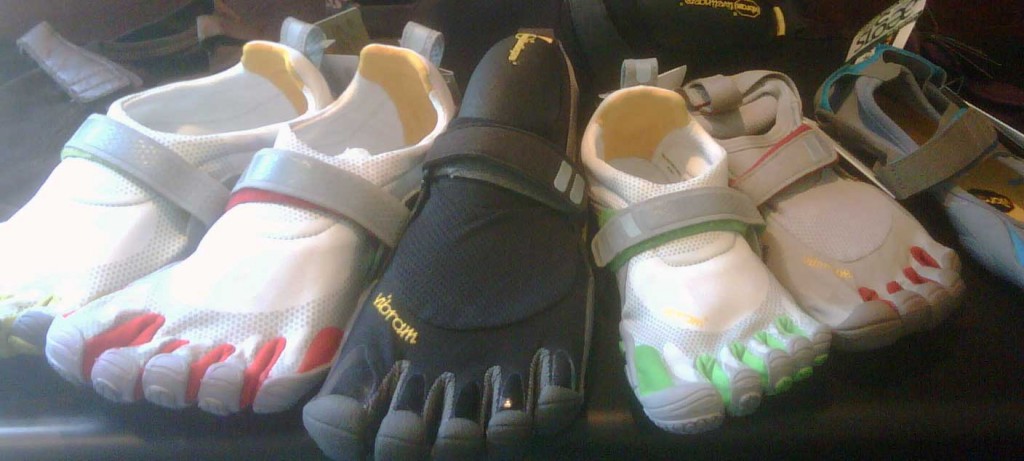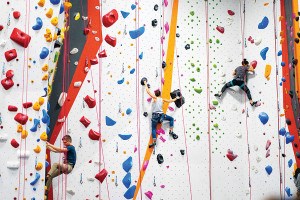Barefoot Running: Fad or Future?
 You’ve probably seen someone wearing a pair of Vibram FiveFingers by now. The last few weekends I’ve even seen a few people running full barefoot. Why are they doing it? Should you run barefoot?
You’ve probably seen someone wearing a pair of Vibram FiveFingers by now. The last few weekends I’ve even seen a few people running full barefoot. Why are they doing it? Should you run barefoot?
Maybe, a little.
Proponents of barefoot running, or its close cousin, minimalist running, believe our bodies were made to run. They feel adding cushioning or controlling devices found in traditional running shoes will only interfere with our naturally perfect feet and strides. But I’ve seen way too many feet to think we have evolved into perfect running machines. Combine that with spending most of our waking hours behind a desk or on a couch? We need to help our bodies as much as possible to stay injury-free.
How we help our bodies and feet has become a much talked about debate over the last few years, sparked in a large part by the book Born to Run. If you haven’t read it, and you need some motivation to start running (or to start running again) you should pick it up. The book focuses on a tribe called the Tarahumara, where running is a way of life. I won’t call them the world’s greatest runners (look up Haile Gebresalase or Kenise Bekele for that!), but they are pretty good, and they run in sandals.
That doesn’t mean you should run in sandals. The Tarahumara might be better if they grew up wearing shoes. What the book does do a great job of is pointing out that we need to see more research about running shoes, form, and injuries. When you look at most of the research cited in Born to Run, you find the conclusions drawn from it are a big leap.
There are some potential benefits of running in minimal shoes. In my opinion, you should get a similar benefit from a variety of shoes. The Vibram 5 fingers and Nike Free have gotten the most attention, but Saucony’s Kinvara or racing flats from many companies can have the same effect.
One of the major benefits to doing a portion of your running in a minimalist shoe can be improved running form. If there is an ideal stride, it is one where you land on your midfoot, with your weight underneath you rather than in front of you. A minimal shoe won’t prevent you from over striding, but the lack of heel cushioning can remind you not to land on your heel (it can hurt). Doing some short runs, preferably on grass or on a softer surface, can give you an idea of what this improved form feels like.
Why not wear them all the time? As you get tired, maybe a half-mile in, maybe five miles in, you will likely be back to your old form. As you get stronger, you should be able to hold the better form for longer durations at a time.
Running—or even walking—in minimal shoes can also help strengthen you lower legs. Most people trying it for the first time will experience some soreness in their calf muscles. The trick here is not to overdo it. Remember going for a long walk in flip-flops and being really sore the next day? Same idea. A little extra stress is okay, too much is an injury.
Running completely barefoot can give you a better feel for the ground than while wearing shoes. This awareness of our foot’s position in space is called “proprioception.” You lose this sense when you drink (it’s why you can’t touch your nose when inebriated). You also lose some of this sense when you put on a glove or sock. What it affects when running is how our body adapts to shock when we land. It takes our body longer to adjust and absorb shock while wearing shoes, even minimal shoes. I’d suggest trying pure barefoot running only on a soft surface free of debris or glass. The infield at Franklin Field might be one of the best spots in Philadelphia. Do a short run over and then take your shoes off and walk or jog a few minutes on the infield. It feels pretty good and you come away with a little better sense of what your body is doing when you run.
You should feel faster in minimal shoes as well. Typically they are about half the weight of a normal running shoe, as well as closer to the ground. I like to use a lighter shoe for races. The trick is finding the mix of how minimal the shoe is and how far you can go in it. Running a 5K might be okay, but for a marathon you will probably want to wear a more protective shoe.
What are the risks associated with these stripped-down shoes? Anyone with loss of feeling in their feet, such as someone with diabetic neuropathy, should probably never attempt to run, or even walk, completely barefoot. We all have very different body types, foot types, and running form. Barefoot running will probably work best for people who are already pretty well aligned and have good form.
At our stores our goal for fitting people in shoes is to keep their feet and bodies in what is considered a neutral position. The idea is that when we are out of alignment—if a foot flattens out for instance—greater stress is put on our muscles and ligaments. In minimal shoes, the idea is to put additional stress on our bodies so that they will adjust to it. Sort of the same principle as toning footwear, which so far have not lived up to the hype.
How much can we adjust to this increased stress? The structure of our feet is widely determined by bone structure. Muscle strength may never increase enough to make running barefoot the best option for most people. Some research even shows increased foot strength in orthotics wearers.
Form is determined by the sum of our parts, not just our feet. Week hip flexors, tight hamstrings, and even the muscles in our neck can change our overall form. Today’s elite runners spend a large amount of time on core strength. Allotting time for core strength training (lunges, crunches, squats) might be a more effective and a safer use of time than running barefoot.
What’s the verdict? Last year more people finished marathons than ever before, and just about all of them ran it and trained in normal running shoes. That seems to be a big plus for running shoes. So far the research is out on whether you should be changing over to more minimal shoes. I don’t believe many podiatrists are recommending running in them.
In the store we carry shoes with a wide range of support, and no one shoe is right for everyone. The more running you do, you will find there is no shoe that feels good for all your runs. You might like that lightweight shoe when your legs feel fresh, but when they are tired and sore from a long run, you might want more support and cushioning.
If you are interested in going minimal, start with walking and progress to very short runs. Imagine that you are starting to run again. Pay close attention to how your feet and lower legs are adjusting and back off if they are overly sore. You may want to read up on improving your form or find a coach who can work with you on form. Be extra careful if you have been prone to other injuries in the past, or if you are also trying to increase the distance of your runs. As in life, a little stress is good, but too much will break us down.
So read Born to Run, get inspired, get running, and then read the cult classic Once a Runner to step into the next level of barefoot running.
Ross Martinson is the running coach for Team Philly and co-owner of Philadelphia Runner. Read more about him and his role at Be Well Philly here.


